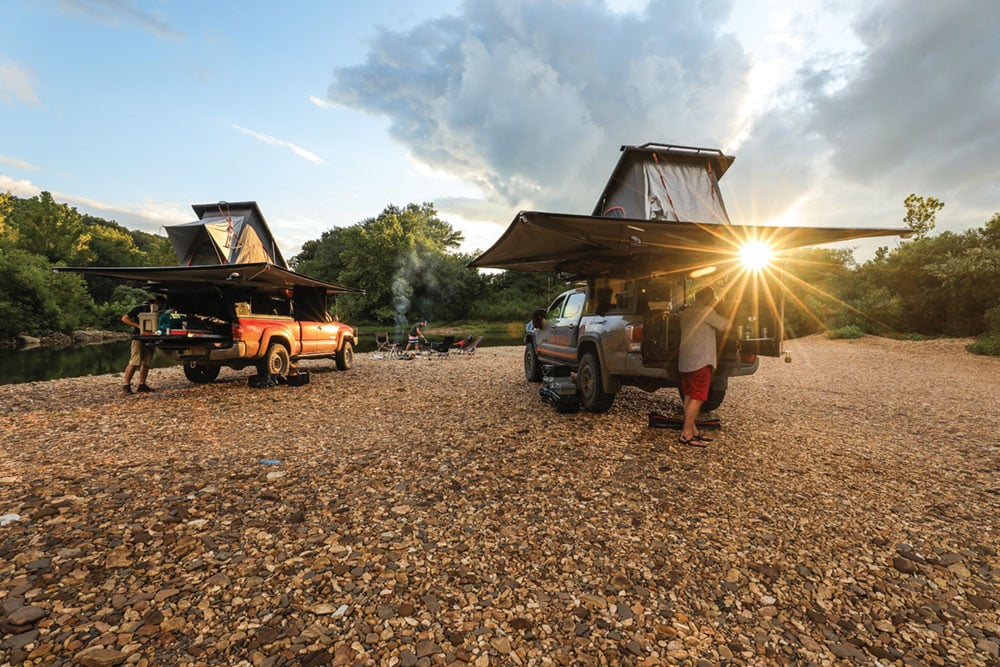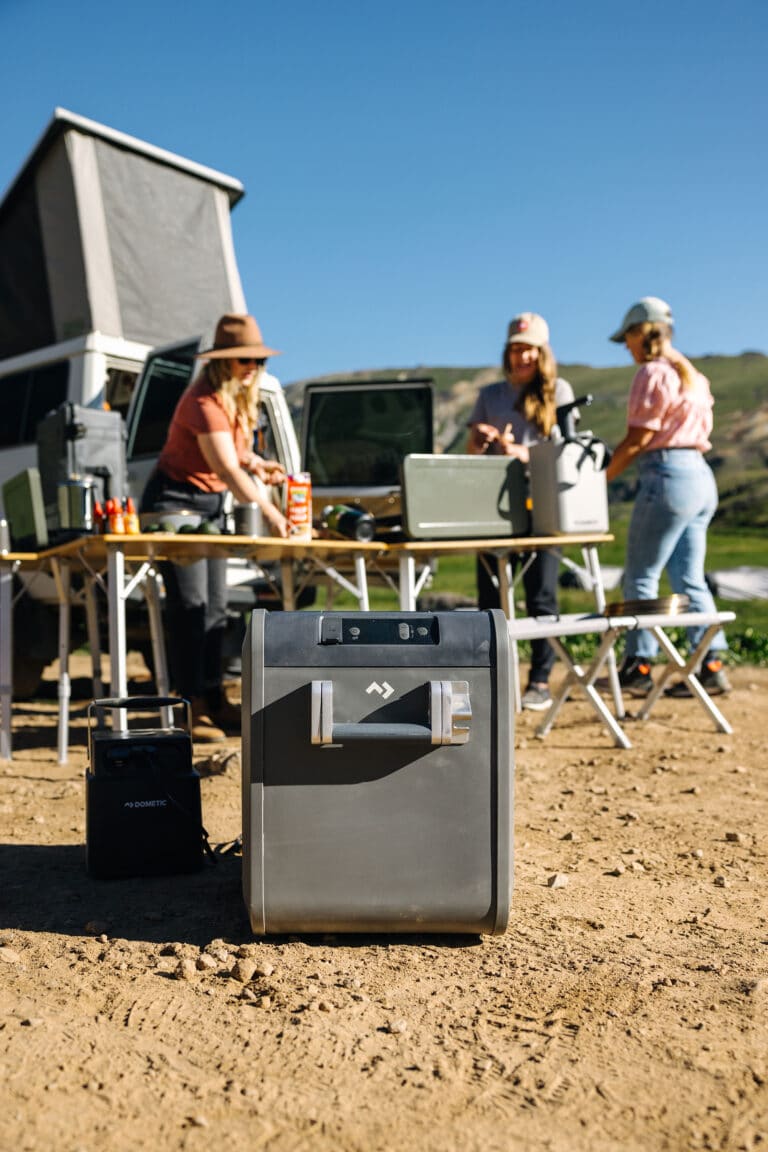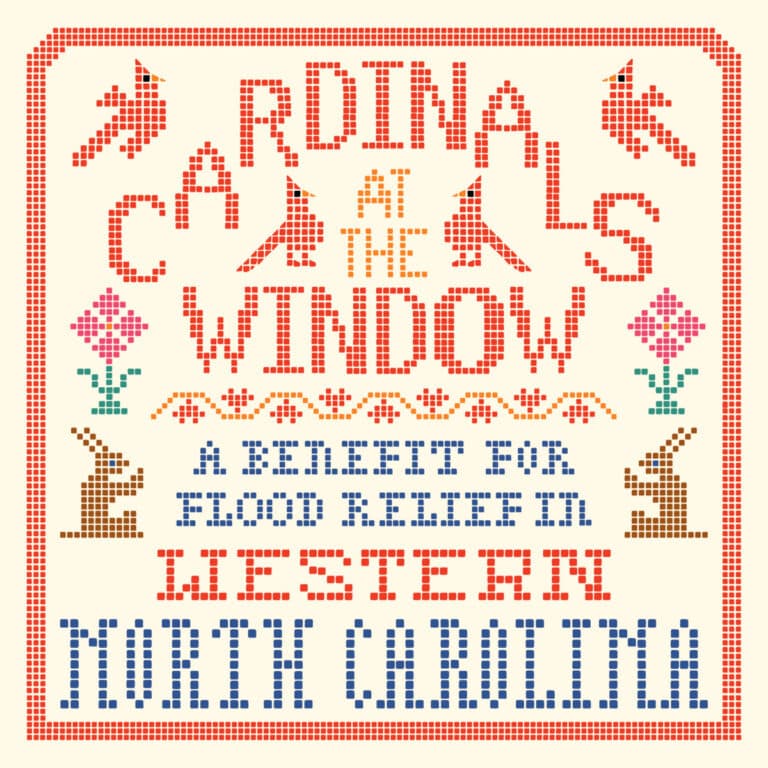In the past two years, the pandemic has inspired people to escape city streets and seek solitude on the backroads of the Blue Ridge and beyond. And ubiquitous transitions to remote work have provided the freedom to be mobile, leading to extended stays in campgrounds and national parks. That’s caused an uptick in demand for adventure-ready vehicles.
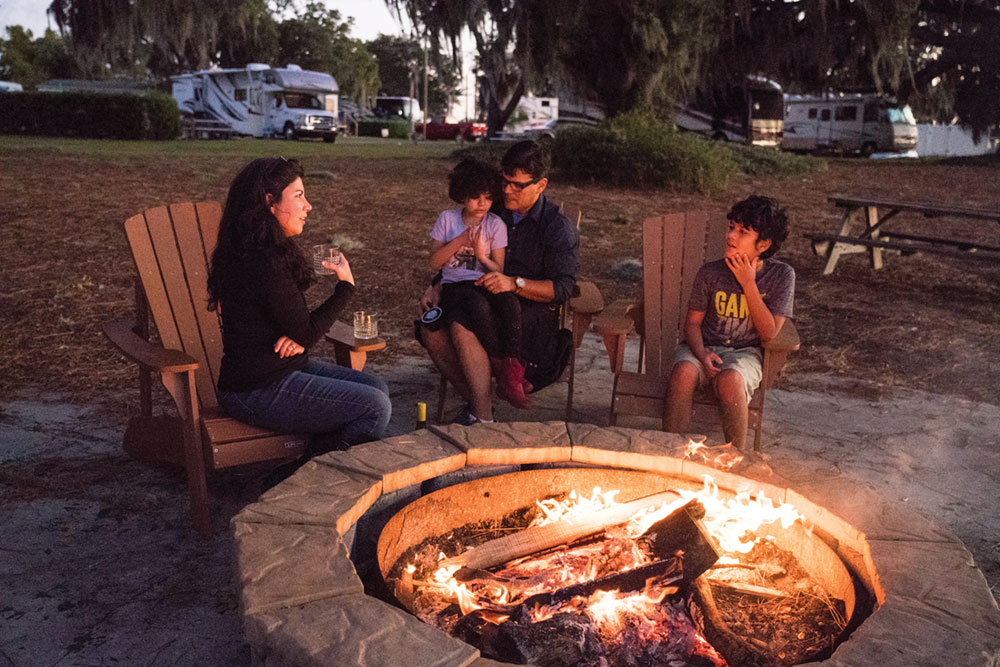
Campers, pop-ups, motorhomes, rooftop tents, vans, remodeled school buses—the options are plentiful, especially as more crafty travelers undertake creative buildouts. Here, adventurers around the region detail their rigs and share tales from the road.
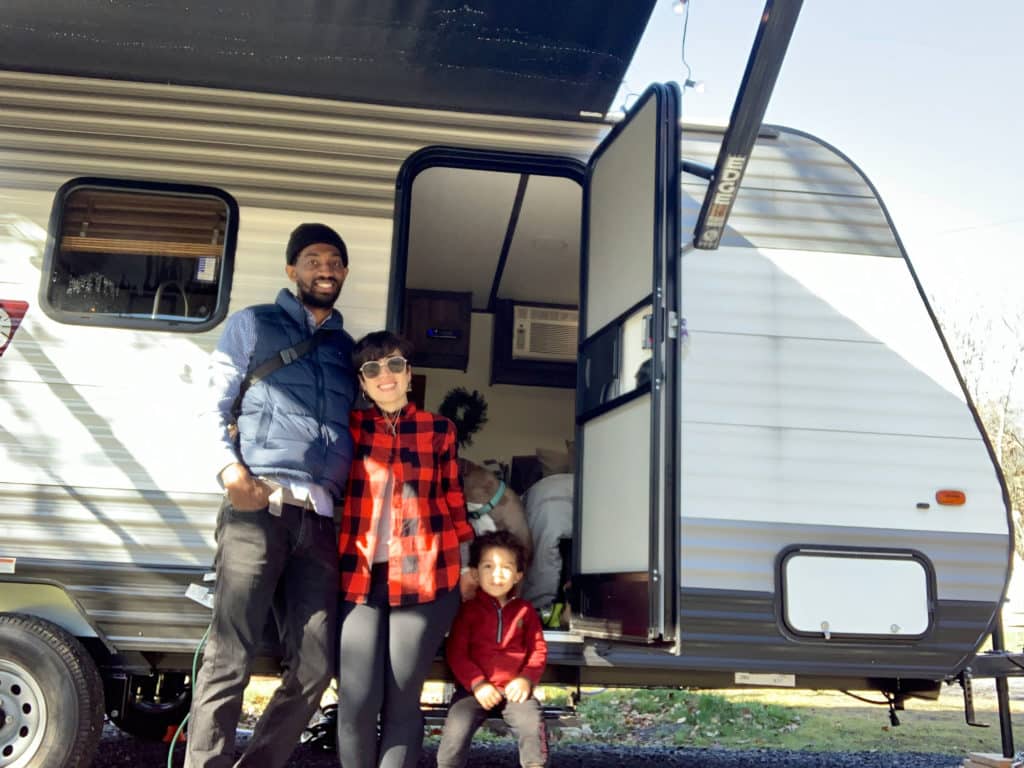
Becoming Weekend Warriors
When the pandemic hit, Stephanie Velez Watson and her husband Ken were looking for a quarantine-friendly way to travel and get outside with their son, Cielo. They quickly realized staying in Airbnbs everywhere was not sustainable, but they still wanted a level of travel comfort that tent camping could not offer.
In the summer of 2020, they purchased what they consider a smaller-sized camper and have not looked back since. “By small, I mean at least can fit me because I’m six feet seven inches,” Ken Watson said.
After finding the right size rig, the couple started the time-consuming process of making it feel like home. From teal cabinets and new tiling to updated cushions and pillows, the Watsons completely remodeled the camper in a week. “We’re kind of those people who go balls to the wall when we’re going to do something,” Velez Watson said.

The Watsons travel one to three weekends a month, mostly staying at cost-effective, mom-and-pop campsites. As parents both working jobs in a hospital, RVing is a great way for the family to disconnect from city life and spend quality time together outside. Even when it is cold, Cielo wants to travel in the camper. “The fact that he just loves it so much—going out, being in the camper, helping me make a fire, going for hikes, just being outdoors and thinking about the simple things in life—that’s what I love about the RV,” Ken said.
The Watsons aren’t the only ones with a newfound affinity for recreational vehicles. According to the RV Industry Association, RV sales increased by nearly 40 percent in 2021 over 2020. Despite issues with the supply chain and rising gas prices, dealers reported selling just over 600,000 units, the biggest sales year on record since 2017.
From Great Smoky Mountains and Shenandoah National Parks to the Jersey Shore, the Watsons traveled all over the region in their first year and a half of owning their camper. They said they felt some hesitation traveling in the South as a family of color, but they found the community at most campgrounds to be welcoming and helpful.
“It’s not too often you walk by someone and say hi unless you know them,” Watson said. “To be a part of the RV family immediately was really nice.”
Along the way, they have been learning how to take care of their own mechanical issues. “If you’re the type of person that needs to bring your rig or automobile to the dealer every single time, it can make it frustrating,” Velez Watson said. “You might not get your rig back for three weeks because Camping World is so busy.” A wealth of resources available online has helped their DIY repair efforts. When they ran into a problem with their electrical system, the Watsons went onto online forums for answers. They even found a Facebook page dedicated to their camper model where another user was able to walk them through a fix.
The learning curves are worth it, all centered around discovering a new way of exploring the outdoors. “We didn’t grow up camping and doing this type of stuff,” Velez Watson said. “It’s nice to be able to introduce that to our son.”
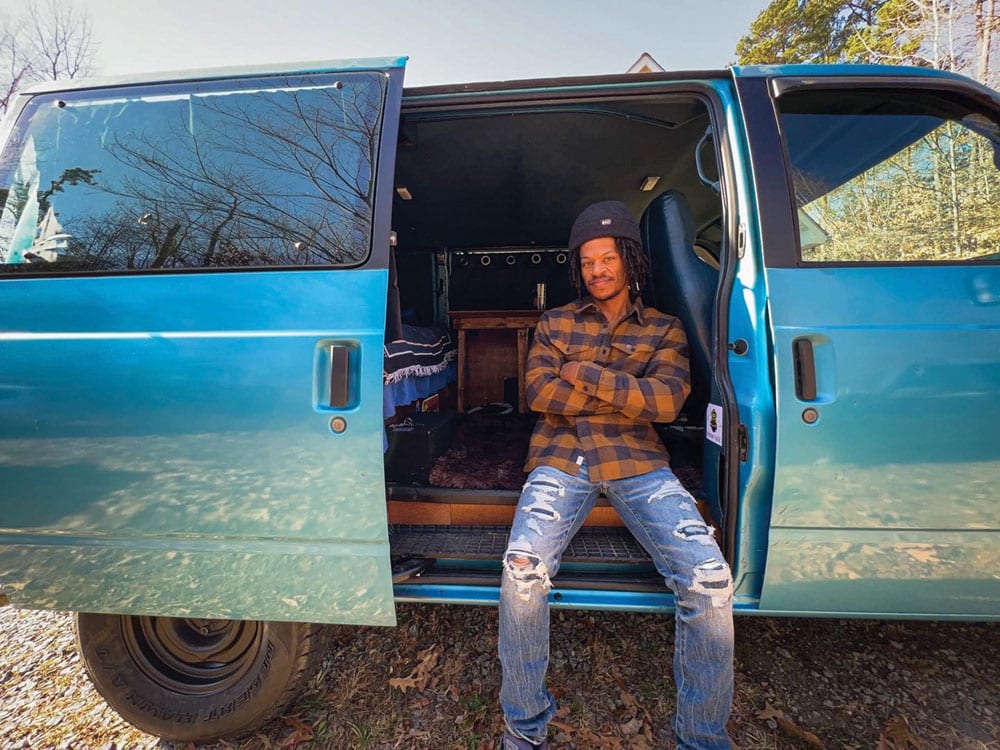
Building Out a New Home
When James Gregory Jr. was a kid, his dad shuttled his basketball team to games in a bright blue Chevrolet Astro van. In 2021, after Gregory quit his job and moved back to Virginia, he realized his dad still had that van more than a decade later. “It was just sitting there at the bottom of the yard,” he said. “Tires were flat; it was all dirty and messed up.” At that moment, it seemed like Gregory’s dream of outfitting a van and living on the road might be possible.
A longtime, self-described gearhead, which he inherited from his grandfather, Gregory first got the idea to fix up a van while working at a car dealership in 2016.
As an avid hiker, backpacker, and paddler, living on the road could mean easier access to trailheads with everything he needed already packed. So when his dad said he could have the van, Gregory jumped right into the remodel.
He didn’t need it to be fancy; he just needed something that would run. Despite its age, Gregory knew the motor had been maintained, and, at 24 miles per gallon, “the gas mileage isn’t the worst for a van.” So Gregory went to work on the vehicle, which he Nicknamed the Mystery Machine for its resemblance to the Scooby-Doo van, ripping out the interior and polished up the exterior.
He said he has spent only about $1,000 on materials during the entire project, saving money by using things he already owned. Whether it was cutting a queen-sized mattress topper in half for his bed, laying out a shag throw blanket for his carpet, or using the grocery net from his car for ceiling storage, he’s found ways to make it work. The one part for the van he has not touched? The iconic blue exterior color. “On the top, it’s peeling and dated, but I love it,” Gregory said. “It gives it a lot of character.”
On Instagram, #vanlife has appeared more than 12 million times, with over half posted in the last three years. But according to Gregory, building out a vehicle for the road life isn’t always as romantic as it seems on social media. “The process is very, very, very frustrating, and things will not go as you think they will go,” Gregory said. “You just have to work around it and make the changes to make it happen.”
The Astro van isn’t perfect. Minor issues have popped up, like a loud exhaust system, persistent check engine light, and rain leaking in through the back doors due to old weatherstripping. But it passes inspection and, to Gregory, who’s starting the road life in earnest this spring with plans to drive the entire Blue Ridge Parkway, it’s starting to feel like home.
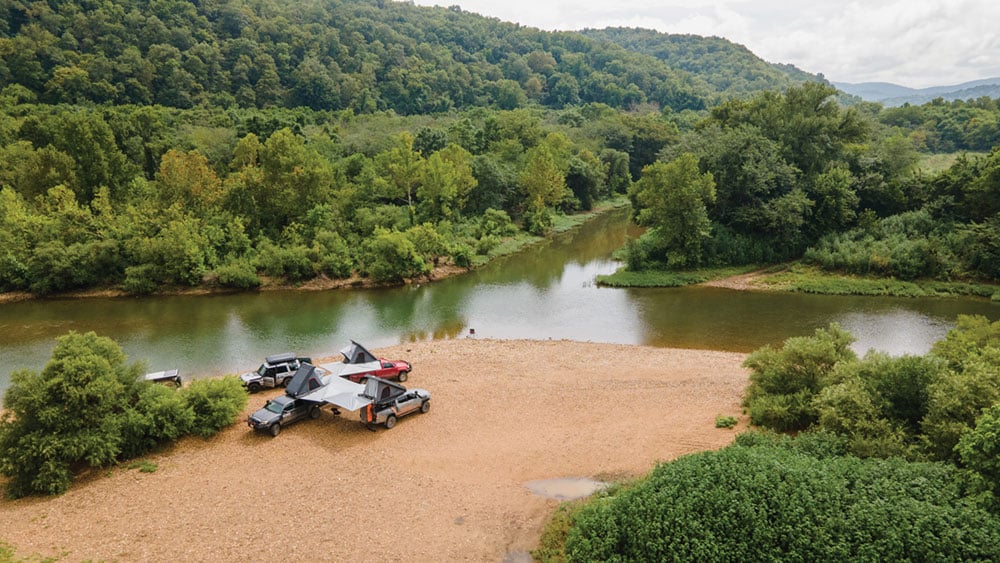
Entering the Rental Market
Shortly into the pandemic, Jason Specht, a trip leader at Mountain State Overland, noticed a shift towards more people seeking safe, self-supported travel. So Specht and the team at the West Virginia-based touring service decided to build out an adventure vehicle to list on Outdoorsy, a website that allows owners to rent out their rigs much like Airbnb.
Last spring, they finished overhauling a Toyota 4Runner named Seneca. They kept the build relatively simple so that first-time users wouldn’t feel overwhelmed with a complicated setup. Every piece that went into the 4Runner was about security, stability, comfort, and ease. “We didn’t want them to feel like they’re heading into the apocalypse,” Specht said.
Seneca is a great option in a growing market. In 2021, Outdoorsy found that 67 percent of its site users were first-time RVers. Specht said attention to detail in the build was key to making sure the 4Runner was appropriate for those with little experience. When a renter’s dog pulled out some wiring under the passenger seat, he was able to quickly identify the problem and make sure it got fixed. “You need to know what goes into it, so if you have to get it repaired over the phone with a renter, you know exactly what conversations to have with that customer or with a shop,” he said.
Outfitted with solar charging, a refrigerator, and a rooftop tent that opens in 15 seconds, the vehicle comfortably sleeps two adults. Since everything collapses and folds back in, adventure rigs like the Seneca are versatile and built to handle off-road terrain. “The fun thing about it for me is (being able to) get deeper into the woods and establish a comfortable base camp,” Specht said.
For Specht, the industry looks a lot different than when he first started building adventure vehicles back in 2013. He remembers a time when his car was the only one on the road with a rooftop tent. Now, it’s not uncommon to pass a customized variety of recreation-ready rigs on any given highway. “It’s crazy how fast it’s adapted in such a short time frame,” he said. “It’s all about the lifestyle you want to live.”
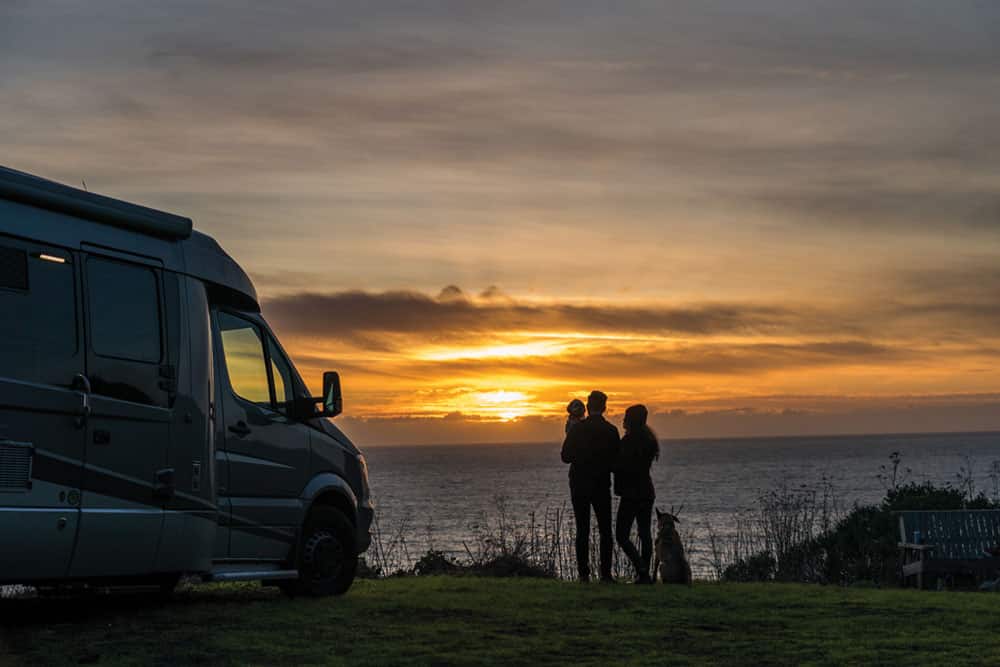
Adventure Vehicle Tips
Rent First
Although there are tons of resources online, including buying guides and do-it-yourself YouTube videos, you can’t beat hands-on experience. Consider renting before you fully commit to buying, and make sure you talk through the vehicle’s quirks with the seller.
Park with Caution
When driving a vehicle that’s bigger than what you’re used to, it might take you a few tries to get the hang of parking. “Do not get to an RV site late,” Ken Watson said. “If it’s dark and you’re trying to back in in something you just got…You won’t realize till the morning, oh man, I’m crooked.” Consider a pull-through site for your first trip or practice parking before you head out. Some rental companies will offer a test drive before you are out on your own.
Match Your Wheels
When it comes to getting your vehicle ready for the road, make sure your tires match your adventure level. “You don’t want street tires that will get gummed up with mud,” James Gregory said. “You’ll get stuck in the backcountry alone with nobody for miles.”
Pick the Right Campsite
There are campsites to fit every budget and type of adventurer, from resorts with amenities like pools and restaurants to backcountry spots with no one around for miles. Websites like Campendium and Harvest Hosts make it easy to find the right option.
Cover photo: Find a place to park your adventure rig by the water. Photo courtesy of Mountain State Overland
